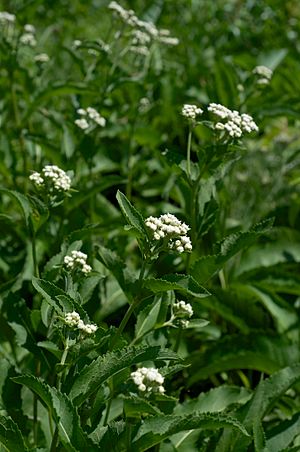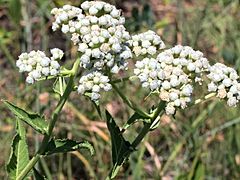Wild quinine facts for kids
Quick facts for kids Wild quinine |
|
|---|---|
 |
|
| Conservation status | |
| Scientific classification | |
| Kingdom: | |
| (unranked): | |
| (unranked): | |
| (unranked): | |
| Order: | |
| Family: | |
| Genus: |
Parthenium
|
| Species: |
P. integrifolium
|
| Binomial name | |
| Parthenium integrifolium |
|
Parthenium integrifolium is a type of flowering plant. It belongs to the aster family. People often call it wild quinine, American feverfew, or eastern feverfew. This plant grows naturally in the eastern and central parts of the United States.
Contents
What Does Wild Quinine Look Like?
This plant is a perennial herb. This means it lives for more than two years. It usually grows to be about three to five feet tall. Its leaves are shaped like ovals or spears. They can be different sizes.
The leaves have special glands. Their edges can be serrated (like a saw), toothed, or lobed (with rounded sections). Scientists sometimes group these plants into two types based on their leaf shapes: var. integrifolium and var. mabryanum.
Its Flowers
The plant's flowers grow in a group called an inflorescence. This group has several "flower heads." Each head looks like one large flower. It is actually made of many tiny flowers. These tiny flowers are called florets.
Each flower head has about 15 or more whitish disc florets. These are in the center. It also has 5 to 6 ray florets. These look like petals around the edge. The flowers have a nice, mild smell. It is a bit like medicine.
Where Does Wild Quinine Grow?
Wild quinine can grow in many places. You can find it in areas that have been disturbed. This includes places where the ground has been moved. It also grows in prairies, which are open grasslands. You can see it in meadows, along the edges of forests, and on hillsides.
This plant likes a lot of sunlight. But it can also grow well in partial shade. It needs soil that drains water easily. This means the water does not sit around its roots. It can grow in sandy soil or good quality clay soil. Wild quinine can handle both hot and cold weather. This makes it a good plant for many gardens.
Blooming Season
Wild quinine blooms for a long time. Its flowers appear from June all the way into September. This makes it one of the longest-blooming perennial plants. Even in winter, the dried flower heads look nice. People often use them for indoor decorations. Many plant nurseries sell wild quinine.
How People Used Wild Quinine in the Past
The leaves of the wild quinine plant have something called tannins. These are natural substances. Native American people used this plant for medicine. They also used it to help their animals.
For example, the Catawba people used it to treat burns. They would make a poultice. This is a soft, moist paste put on the skin. They also used the ashes of the plant. They put these ashes on horses with sore backs. The roots of the plant were used to make a tea. This tea helped with stomach problems.



